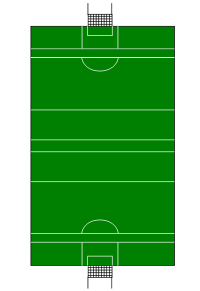Gaelic football
Gaelic Football (Irish: Peil, Peil Ghaelach or Caid ), commonly referred to as "football", or "Gaelic", is a form of football played mainly in Ireland. It, along with Hurling, is the most popular spectator sport in Ireland.[1]

Gaelic football is played by teams of 15 on a rectangular grass pitch with H-shaped goals at each end. The object is to score by kicking/striking the ball with your hand and getting it through the goals. The team with the highest score at the end of the match wins. Getting the ball into the net scores 3 points; getting it between the posts but above the goal scores 1 point.
Players advance the ball up the field with a combination of carrying, soloing (dropping and then toe-kicking the ball upward into the hands), kicking, and hand-passing to their team-mates.
Gaelic football is one of four Gaelic Games run by the Gaelic Athletic Association, the largest sporting organization in Ireland. It has strict rules on player amateurism. The game is believed to have come from ancient Irish football known as caid which dates back to 1537, although the modern game took shape in 1887.

Playing field
changeThe grass pitch is rectangular, stretching 130–145 metres long and 80–90 metres wide. There are H-shaped goalposts at each end with a net on the bottom section. The same pitch is used for hurling; the GAA, which organizes both sports, decided this to facilitate dual usage. Lines are marked at distances of 13m, 20m and 45m from each end-line. Shorter pitches and smaller goals are used by under-12s and under 10s.[2]
Duration
changeAll Gaelic football matches last for 60 minutes, divided into two halves of thirty minutes, with the exception of senior inter-county games which last for 70 minutes (two halves of 35 minutes). Draws are decided by replays or by playing 20 minutes of extra time (two halves of 10 minutes) or elas in a penalties shoot out.
Teams
changeTeams consist of fifteen players (a goalkeeper, two corner backs, a full back, three half backs, two mid fielders, three half forwards, two corner forwards and a full forward) plus up to fifteen substitutes, of which five may be used. Each player is numbered 1–15, starting with the goalkeeper, who must wear a different coloured jersey.
The ball
changeThe game is played with a round leather football, similar to a soccer ball, but heavier, and with horizontal stitching rather than the hexagon and pentagon panels often used on soccer balls, and similar to a standard volleyball.
Other websites
change- Rules Archived 2008-04-10 at the Wayback Machine
- Official GAA website
- An Fear Rua - The GAA Unplugged! Archived 2010-04-08 at the Wayback Machine -GAA site with news, views, fun and chat...
- Unofficial GAA Messageboard
References
change- ↑ "GAA attendance figures" (PDF). Archived from the original (PDF) on 2006-05-26. Retrieved 2006-11-27.
- ↑ "GAA pitch size". Retrieved 2007-05-06.